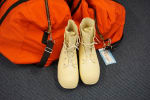Last week, Christmas was celebrated in many parts of the world, and that includes the South Pole. They had a makeshift “cargo” tree, presents for the winterovers, a fancy dinner—complete with a printed menu and assorted European desserts, and a party in the gym. […]
Week 50 at the Pole
It might be cold, but it’s summer at the South Pole, and the sun was out in full force, captured in this image of the IceCube Lab (ICL) with a striking mass of clouds cutting a swath through the sky. […]
IceCube welcomes Tintin to the South Pole
The IceCube team in Brussels has been getting ready for a special deployment to the South Pole. On December 11, Gwen de Wasseige, a graduate student at the Interuniversity Institute for High Energy Physics (IIHE), left Belgium for Antarctica, to take part in the austral summer maintenance and operations activities at the IceCube Neutrino Observatory. However, she was not flying on her own but in the company of one of the most famous Belgians of all time, Tintin. […]
Everything you always wanted to know about the IceCube detector
For the first time, the IceCube Collaboration is making public every detail of the only cubic-kilometer neutrino detector to date, from a flasher board in the digital optical modules—aka DOMs—to the calibration processes that allow researchers to measure the properties of neutrinos, or to the IceCube Live website that IceCubers use to monitor what is going on in the detector. The publication, over 70 pages long, has just been submitted to the Journal of Instrumentation. […]
Week 49 at the Pole
A busy week at the South Pole, but not too busy for fun and games. Last week they held a foosball tournament at the geographic pole. In fact, it apparently was the first international southernmost foosball tournament, period. And IceCube winterover Martin was one of the winners. Yay, team! […]
Week 48 at the Pole
Not many people have the opportunity to go to the South Pole. It’s remoteness and extreme climate make traveling there complicated, and access to the South Pole station and other research facilities at the Pole is restricted or limited at best. […]
Week 47 at the Pole
Have we mentioned all the cables? Well, there are a lot of cables in the IceCube Lab, and sometimes they’re a bit in the way, as they appear to be in this image of winterover Martin trying to get at something in the computer rack that needs attention. […]
Week 46 at the Pole
Ok, they’re gone, but you can see them one last time in this photo taken mere moments before they left. Who? IceCube’s outgoing winterovers, whose departures from the Pole had suffered some delays. The group photo includes IceCuber Ralf Auer, just arrived on the plane that was soon to take Christian and Mack away, along with current winterovers James and Martin. […]
Exploring blazars as astrophysical neutrino sources
A new study from the IceCube Collaboration searched in three years of IceCube data for directional clustering of neutrinos around gamma-ray sources associated with blazars from the second Fermi-LAT AGN catalog. Although some enhancements in the observed neutrino rate from these blazars were found in the 3–30 TeV region, all of them are compatible with fluctuations of the atmospheric neutrino background. These results, recently submitted to The Astrophysical Journal, open several new analyses exploring blazars as very high energy neutrino sources. […]
Week 45 at the Pole
Last week at the Pole was a week of no airplanes. Not only did that postpone the departure of current IceCube winterovers Mack and Christian (who was captured in this image expressing his feelings about the delay), but it prevented US Secretary of State John Kerry from making a scheduled visit to the South Pole. […]









